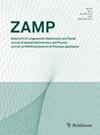三波共振相互作用模型:平面波的谱和不稳定性
IF 1.6
3区 数学
Q2 MATHEMATICS, APPLIED
Zeitschrift fur Angewandte Mathematik und Physik
Pub Date : 2023-09-27
DOI:10.1007/s00033-023-02104-8
引用次数: 0
摘要
摘要三波共振相互作用模型(3WRI)是一种具有二次耦合的非色散系统,在非线性光学、流体和等离子体物理等领域都有广泛的应用。利用它的可积性,特别是它的Lax对表示,我们对共振条件下受局域摄动扰动的平面波解进行了线性稳定性分析。根据系统本身及其平面波解中出现的物理参数,给出了所谓稳定谱的拓扑分类。除了稳定性谱外,我们还计算了相应的增益函数,从中我们推断出该系统对于任何一般物理参数的选择都是线性不稳定的。除了在两个耦合非线性Schrödinger方程的系统中观察到的稳定性谱,其非消失增益函数检测调制不稳定性的发生外,3WRI系统的稳定性谱具有新的拓扑成分,其相关增益函数与表征调制不稳定性的增益函数不同。根据调制不稳定性与异常波发生之间的联系,我们推测基带型的线性不稳定性可能是3WRI系统中异常波类型发生的必要条件,从而为预测扰动的后续非线性演变提供了工具。本文章由计算机程序翻译,如有差异,请以英文原文为准。

The 3-wave resonant interaction model: spectra and instabilities of plane waves
Abstract The three wave resonant interaction model (3WRI) is a non-dispersive system with quadratic coupling between the components that finds application in many areas, including nonlinear optics, fluids and plasma physics. Using its integrability, and in particular its Lax Pair representation, we carry out the linear stability analysis of the plane wave solutions interacting under resonant conditions when they are perturbed via localised perturbations. A topological classification of the so-called stability spectra is provided with respect to the physical parameters appearing both in the system itself and in its plane wave solution. Alongside the stability spectra, we compute the corresponding gain function, from which we deduce that this system is linearly unstable for any generic choice of the physical parameters. In addition to stability spectra of the same kind observed in the system of two coupled nonlinear Schrödinger equations, whose non-vanishing gain functions detect the occurrence of the modulational instability, the stability spectra of the 3WRI system possess new topological components, whose associated gain functions are different from those characterising the modulational instability. By drawing on a recent link between modulational instability and the occurrence of rogue waves, we speculate that linear instability of baseband-type can be a necessary condition for the onset of rogue wave types in the 3WRI system, thus providing a tool to predict the subsequent nonlinear evolution of the perturbation.
求助全文
通过发布文献求助,成功后即可免费获取论文全文。
去求助
来源期刊
CiteScore
2.90
自引率
10.00%
发文量
216
审稿时长
6-12 weeks
期刊介绍:
The Journal of Applied Mathematics and Physics (ZAMP) publishes papers of high scientific quality in Fluid Mechanics, Mechanics of Solids and Differential Equations/Applied Mathematics. A paper will be considered for publication if at least one of the following conditions is fulfilled:
The paper includes results or discussions which can be considered original and highly interesting.
The paper presents a new method.
The author reviews a problem or a class of problems with such profound insight that further research is encouraged.
The readers of ZAMP will find not only articles in their own special field but also original work in neighbouring domains. This will lead to an exchange of ideas; concepts and methods which have proven to be successful in one field may well be useful to other areas. ZAMP attempts to publish articles reasonably quickly. Longer papers are published in the section "Original Papers", shorter ones may appear under "Brief Reports" where publication is particularly rapid. The journal includes a "Book Review" section and provides information on activities (such as upcoming symposia, meetings or special courses) which are of interest to its readers.

 求助内容:
求助内容: 应助结果提醒方式:
应助结果提醒方式:


